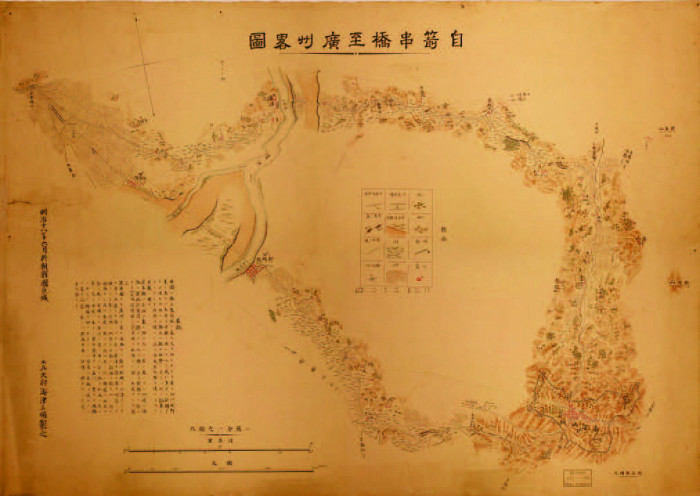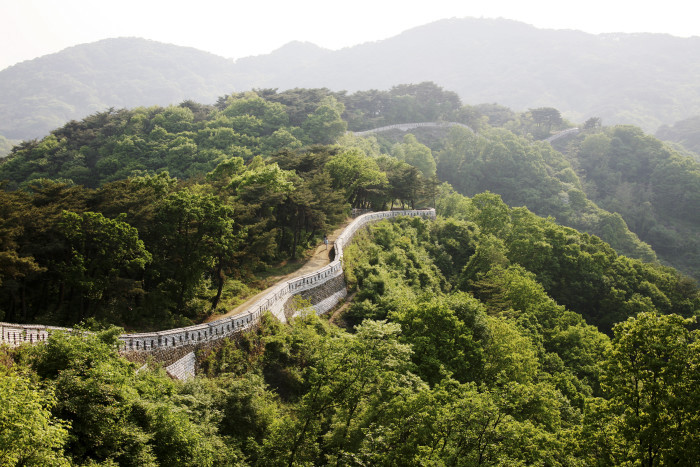경기문화재단
Neunghaeng & Peddlers’ old paths
The old Namhansanseong path
"Stories on the Road" is a story about a UNESCO World Heritage site and a story. It will tell you the life and spirit of our ancestors in the ancient road of The old Namhansanseong path. |
"A path to royal tombs for kings, a commercial route for private trade"
 An ancient map marking the old Namhansanseong path (Bonghwaro)
An ancient map marking the old Namhansanseong path (Bonghwaro)
/ Haedong Map / 1750

A map marking the old Namhansanseong path (Bonghwaro) from the late Joseon period / Jajeongotgyo Gwangju Jiryakdo / 1885
The cities of Seongnam, Gwangju, and Hanam, where today's Namhansanseong Fortress is located, were all under the jurisdiction of Gwangju Yusubu in terms of the Joseon Dynasty's administrative districts. Gwangju Yusubu was an extremely important center for administration due to the fortress' nature as a military strategic point. Also, Namhansanseong Fortress is a place closely related to the movements of the kings of the time. Joseon kings had to occasionally visit the tombs of previous kings, and such a visit was called neunghaeng, or a royal visit to the tombs. When the later kings went to pay their respects at Yeongnyeongneung, they had to make several trips each year to Yeoju via the old Namhansanseong path. Another characteristic of the old Namhansanseong path is that it was also a commercial route often used for private trade as an inland distribution network, which become a necessity as the number of commercial transactions increased in the late Joseon period. Numerous peddlers accounted for a significant part of the commercial distribution of the time by the old Namhansanseong path, which was commonly called Bonghwaro after the final destination of the path, Bonghwa in Gyeongsangbuk-do.
“Peddlers and Jangdolim culture”

Bobusang, or peddlers, were salespeople who carried goods on their backs and sold them while travelling from one area to another. Bosang refers to people who wrapped and carried goods on their heads, primarily female. In contrast, busang would sell large pottery, plates, bamboo products, salt, etc. Bobusang served as a significant part of commercial distribution through the major ground arterial road network including Samnamro, Yeongnamro, Uijuro, and Bonghwaro (the old Namhansanseong path). As marketplaces were set up throughout the country, they went from one marketplace to another held on specific dates to sell items, which is how they came to have the name jangdolbaengi, which means traders who visit markets to sell products. As commerce became important and the scope of their activities expanded, many taverns and inns were established on roads through which bobusang would travel. Although the bobusang name has disappeared, the names of areas that they have left and the jangdollim culture at 5-day markets are still kept by modern travelling merchants today.
Old roads into which the traces of old lives are immersed,
and the disappearing traces of lives

The old Namhansanseong path is a road filled with the joys and sorrows of many scholars taking examinations and the bobusang and jangdolbaengi who traveled from one marketplace to another with their goods on their backs. It is an old road with the traces of the lives of many people, but now these old roads are going to make way for cars. It is sad to see the continuous disappearance of the signs of life carried on and layered by countless people, the faith in Seonangdang and Jangseung that had been maintained for thousands of years, and the yeokcham and mabang through which secret royal inspectors with mapae would travel and from which pabal personnel borrowed horses and delivered emergency communication about enemy threats. Furthermore, people are forgetting the memories of the volunteer troops gathering and defeating enemies, and their march to Seoul, as well as people evacuating and returning home later on the same path. Although we may not retrogress on social changes that seek efficiency and convenience, shouldn’t we leave the traces of our ancestors’ lives that have been recorded on the paths for thousands of years before clearing them away for cars?
<ggc의 모든 콘텐츠는 저작권법의 보호를 받습니다.>
세부정보
Stories on the Road
Published by/ Namhansanseong World Heritage Centre, Gyeonggi-do The Center for Gyeonggi Studies, Gyeonggi Cultural Foundation
Published on/ November 24, 2017
Supervised by/ Lee Ji-hoon, Director of the Center for Gyeonggi Studies, Gyeonggi Cultural Foundation
Planned and coordinated by/ Chae Chi-yong, Senior Researcher at the Center for Gyeonggi Studies, Gyeonggi Cultural Foundation Park Da-seul, Researcher at the Center for Gyeonggi Studies, Gyeonggi Cultural Foundation